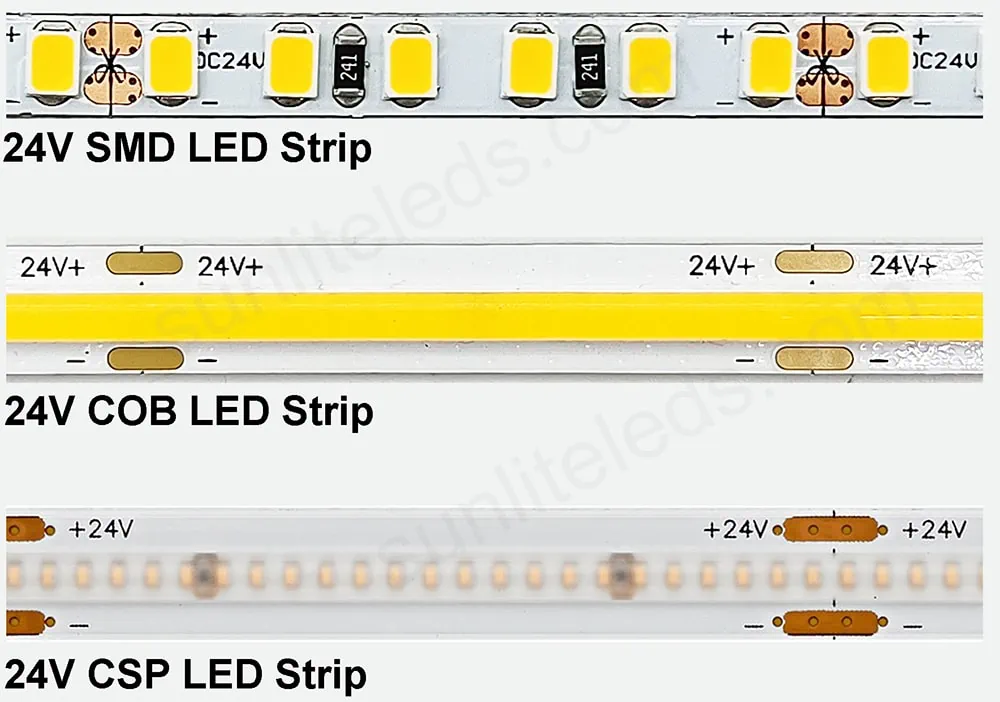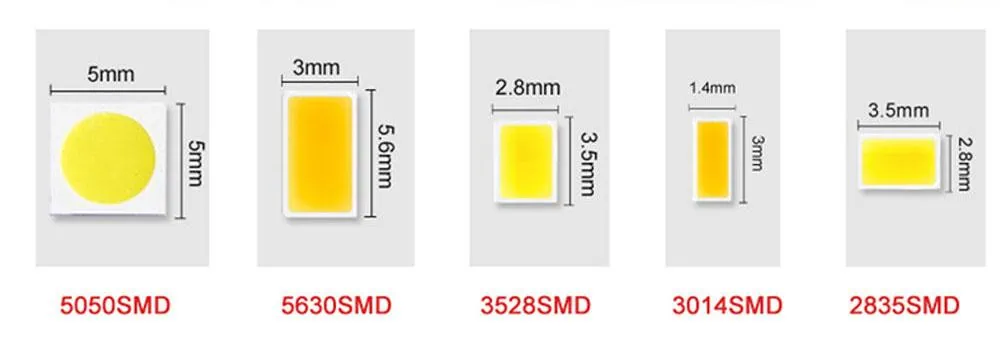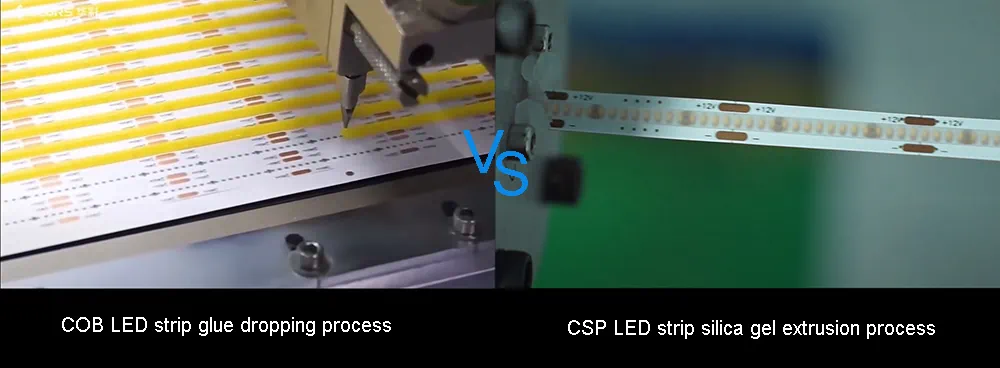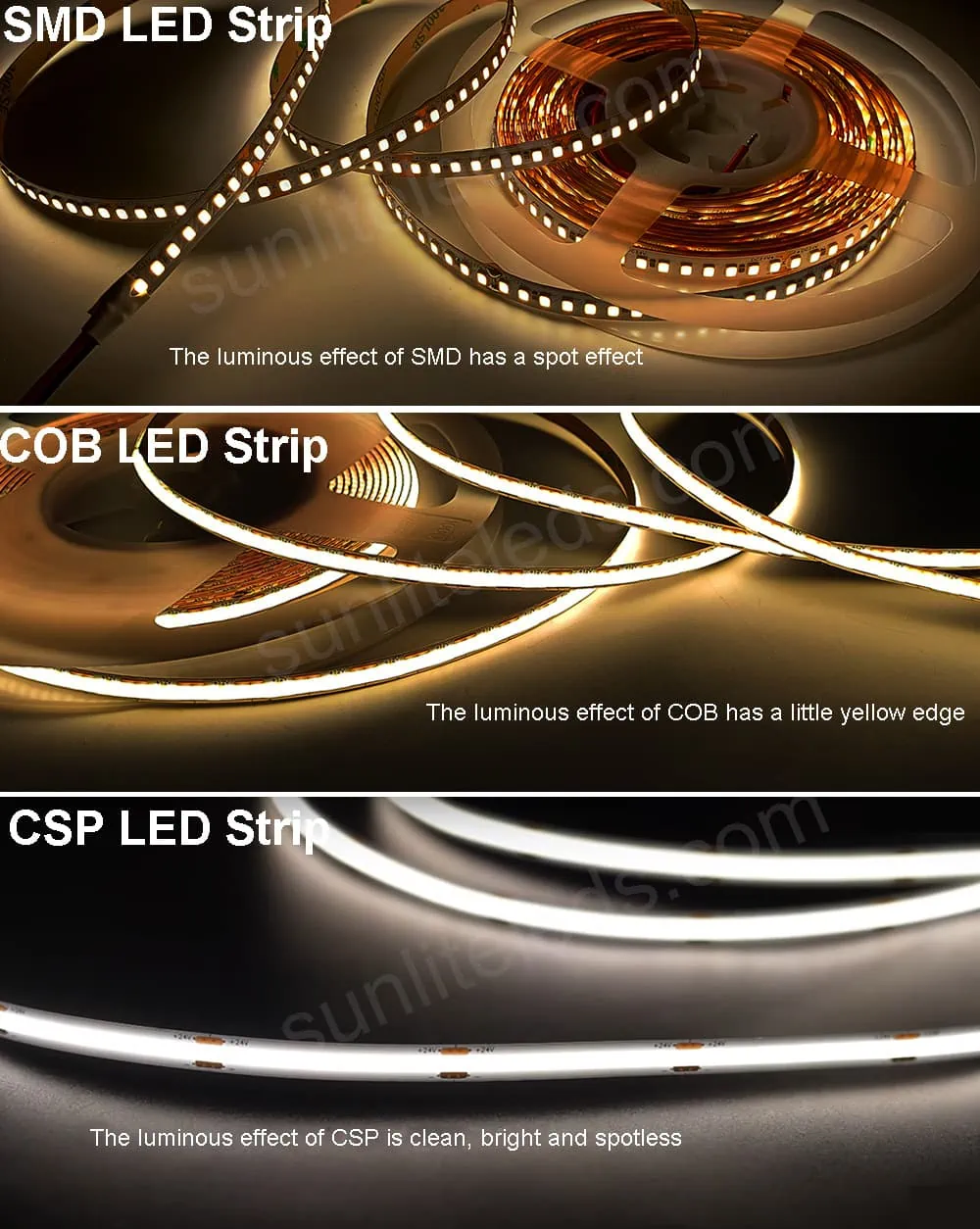SMD LED strips are the most popular on the market, and there are several variations to pick from. COB LED strips are popular in the industry due to their excellent linear effects. Because of its sophisticated chip packing technique, the new CSP LED strip is setting a new industry standard. So, what are the advantages of CSP LED strips over standard COB and SMD LED strips? In this post, we’ll look at the distinctions between SMD, COB, and CSP LED strips.

First, let us quickly understand the comparison items between SMD LED Strip vs COB LED Strip vs CSP LED Strip through the table below.
SMD LED Strip vs COB LED Strip vs CSP LED Strip Comparison Table
| Feature | SMD LED Strip | COB LED Strip | CSP LED Strip |
|---|---|---|---|
| Appearance | “Dot-like” LED strip using white or black PCB, without glue. | Typically has yellow glue due to phosphor mix. | Translucent milky white glue, no phosphor mix. |
| Color Tolerance | 5-step Macadam color tolerance. | 5-step Macadam color tolerance. | 3-step Macadam color tolerance. |
| Light Efficiency | Highest due to lack of glue, 100/150/200 lm/W | Lower due to yellow phosphor mix, 100/130 lm/W | Higher due to translucent milky white |
| Light Uniformity | Dot effect due to dispersed light across multiple lamp beads. | Better, with no light dot effect. | Better, with no light dot effect. |
| Packaging Tech | Single LED chip encapsulated in a lamp bead, with brackets. | Multiple LED chips integrated on a board, without brackets. | Chips directly to the PCB without an intermediate substrate or package, with brackets. |
| Brightness | Brightness due to LED chips size and density. | Brighter due to multiple LED chips. | Brightness varies, generally less than COB. |
| Heat Dissipation | Easier due to simpler structure. | Complex structure makes it harder. | Better thermal performance. |
| Cost | Less | More | More |
| Application | Customized decorative lighting. | Spot-free seamless lighting. | High-quality lighting |
Keep reading. Let’s understand the main features of SMD LED Strip vs COB LED Strip vs CSP LED Strip.
SMD LED Strip vs COB LED Strip vs CSP LED Strip Highlights
Abbreviations
SMD: Surface-Mounted Device
COB: Chip On Board
CSP: Chip Scale Package
Unique Features
SMD LED Strip
SMD LEDs are available in a variety of sizes, producing a variety of colors including RGB (red, green, blue), a wide range of brightness options, and design flexibility.
COB LED Strip
No spot effect that appears in SMD LED strips, high luminous efficiency and luminosity, good durability, and not easy to be damaged.
CSP LED Strip
The ultra-compact design reduces the LED chip area without affecting light efficiency, high performance, good color consistency, and high application flexibility.
Now let’s take a look at SMD LED strip, COB LED strip and CSP LED strip one by one.
SMD LED Strips
SMD Technology
SMD refers to “Surface Mount Device” LED strips, which are the most common LEDs on the market. LED chips are permanently fused to a printed circuit board (PCB) and are particularly popular for their versatility. The PCB is built on a rectangular, flat object, which is what we usually see as SMD. If you look closely at the SMD LED, you can see a small black dot in the center of the SMD; that is the LED chip, usually used in addressable LED strip.
SMD LED chips are available in various sizes: 2835, 3030, 3014, 5050, 5630; they are named according to their dimensions: length and width. For example, the dimensions of the 2835 are 2.8 x 3.5mm, the 3030 is 3.0 x 3.0mm, the 3014 is 3.5 x 2.8mm, the 5050 is 5.0 x 5.0mm, and the 5630 is 5.6 x 3.0mm. SMD chips are small in size and are close to the design of flat, square computer chips.

The LED chip is fixed on the pad of the lamp bead bracket. It is then soldered and has the same conductive properties as the COB package. SMD LEDs must be mounted before being fixed on the PCB board through reflow soldering. After performance testing, it is encapsulated with epoxy resin glue. Next, it will be divided, cut and pasted, and then transported to the screen factory and other processes.
SMD LED Strip Advantages
Brighter: SMD LEDs emit a broader beam angle. As a result, despite the fact that SMD LEDs consume the same amount of electricity, they generate brighter light.
Economical: Compared to COB LEDs, SMD LEDs can be manufactured on a bigger scale and are less expensive.
Low heat output: SMD LEDs produce less heat while delivering brighter light than COB and high-power LEDs due to their reduced current and voltage requirements.
Easy to install: Surface mount devices (SMDs) enable electrical components to be installed or positioned directly on the surface of a circuit board, making installation simple.
Longer Lifespan: SMD LEDs are affordable and may last up to 50,000 hours or more, saving you even more money on maintenance.

Suntech Lite provides the best customized SMD LED strip, for example individually controlled LED strips.
COB LED Strips
COB Technology
COB is an acronym for Chip on Board, which indicates that the LED chip is directly placed on the circuit board (PCB), which is equivalent to chip packing technique. The COB light source is an efficient integrated surface light source technology that directly connects LED chips to high reflectivity mirror metal surfaces. The solution removes the need for mounts and is more efficient than LED lighting.
COB LED strips are made up of individual chips packed on a flexible board. The chip is primarily a flip chip, which is linearly fixed to the PCB board. One of the major motivations for mounting these LEDs directly on a substrate is to improve chip density, which results in a powerful light source. Then, apply a layer of encapsulant mixed with phosphor straight to the chip surface. The light released by the chip is refracted, reflected, and interacts with the phosphor, while the glue emits light of varying hues and temperatures.
COB LED Strip Advantages
Seamless light: Because the LEDs are firmly packed on the carrier, COB LED strips distribute light evenly with no obvious hot or dark patches.
Compact design: COB LED strips are extremely thin and compact, making them excellent for applications requiring a low-profile design.
Efficient heat dissipation: The LED is directly mounted on the carrier, resulting in efficient heat dissipation and extending the life of the light strip.
High Brightness: COB LED strips are often brighter than regular LED strips, making them perfect for applications that demand intense lighting.

CSP LED Strips
CSP Technology
CSP, chip scale packaging, refers to an LED package whose size is the size of an LED chip or no more than 20%. This is an attempt to reduce the size of the LEDs that can be mounted on the substrate, which essentially means more LED chips on the substrate. These LEDs are placed on microchips that are so small that they can be mounted directly onto a carrier board. This opens the door to unprecedented flexibility and performance in LED strip lighting.
CSP LED Strip Advantages
Compact design: CSP LED strips are incredibly slender and small, making them excellent for applications with limited space or those require a delicate lighting design.
High brightness: Despite their tiny size, CSP LED strips are extremely bright, providing even and intense lighting.
Efficient heat dissipation: Because the LED chip is directly installed on the carrier board, no soldering wire connection is necessary, which reduces thermal resistance and improves heat dissipation, extending the life of the strip.
Versatile Applications: CSP LED strips are versatile because of their small size and flexibility, making them suitable for decorative, accent, and professional lighting applications.
Do you already know the differences between the three types of LED strips? Now let us further analyze the comparison table at the beginning of the article.
SMD LED Strip vs COB LED Strip vs CSP LED Strip Comparison Table Analysis
Appearance: The appearance of the SMD light strip is a “dot-like” LED strip using white or black PCB, without glue. Unlike SMD, COB and CSP light strips use glue for their appearance. COB LED strips use yellow gum mixed with phosphors, which help produce a specific color output and affect light efficiency. In contrast, CSP LED strips use a translucent opalescent glue and contain no phosphors, which has a positive impact on their color tolerance and efficiency. SMD does not use glue, so the light efficiency is higher.
Color tolerance: Color tolerance indicates the consistency of color output across different LED strips.
The color tolerance of SMD LED strips can vary depending on the specific model and manufacturer. High-quality SMD LED strips can achieve tight color tolerances similar to CSP LEDs, especially in newer models like the 2835 and 5730.
Standard SMD LED strips might offer a color tolerance around a 5-step Macadam ellipse or wider, similar to COB LED strips. CSP LED strips offer superior color consistency with a 3-step Macadam color tolerance, which is more precise than the 5-step tolerance of SMD or COB LED strips. This is because CSP LEDs’ smaller size allows for more precise binning during manufacturing.
Light Efficiency: Light efficiency refers to the light output per watt of power consumed. SMD LED strips have the highest light efficiency, usually 100 lm/W, 150 lm/W, or even 200 lm/W. The yellow phosphor mixed glue of COB LED strips will reduce the light transmittance, usually between 100 and 130 lm/w. Compared with COB LED strips, CSP LED light strips have higher light efficiency because they are covered with translucent milky white glue.
Light Uniformity: SMD LED strips disperse light onto multiple lamp beads, creating a “dot effect.”. Because the lamp beads of the COB LED strip are sealed in glue, COB LED strips provide better light uniformity, meaning the light is evenly distributed without “hot spots” or variations in brightness. CSP LEDs require no external packaging, and the chips are placed more closely. Better light uniformity compared to traditional SMD LEDs.
Packaging technology: COB LED light strips integrate multiple LED chips directly onto the circuit board without the need for brackets. Higher brightness and uniformity can be achieved, but it also complicates the heat dissipation process. SMD LED strips, which work by encapsulating individual LED chips in individual beads, require brackets but may not match the brightness and uniformity of COB strips. CSP LED strips install the LED chip directly onto the PCB and require a bracket. CSP does not require packaging, thereby reducing the size of the LED and having better thermal performance.


Brightness: The integration of multiple LED chips makes COB LED light strips brighter than SMD LED strips. CSP LED is second only to COB LED. The brightness of SMD LED strips depends on the size and density of individually packaged LED chips. Changing the size and density of LED chips can adjust the brightness of SMD LED strips.

Heat dissipation: SMD LED strips have a simpler design and less heat build-up. COB LED strip package copy, high LED density requires additional cooling. CSP LED strips have better thermal performance and are the best choice in limited spaces and lower temperatures.
Purchase cost: SMD LED strip has a low purchase cost due to its simple design. COB LED strip is more expensive than SMD due to its complex packaging technology. CSP LED strips have the highest initial purchase cost due to their efficient design.
Application Scenarios: SMD LED light strips are flexible in color and suitable for customized decorative lighting. COB LED strips have a spot-free appearance for seamless lighting with no dark areas. The compact and efficient design of CSP LED strips makes them suitable for high-quality lighting applications where space is limited.
SMD LED Strip vs COB LED Strip vs CSP LED Strip: Which LED strip should you choose for your project? Is it an energy-efficient LED strip? Need an LED strip with no spot or dark area lighting? Have you considered? Each type LED strip has its own unique advantages. If you don’t know how to choose, please contact our professional LED engineers.
